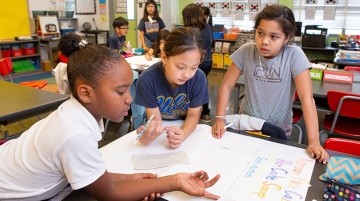Language and culture are central to learning and human development, as they shape the ways in which we all learn and grow together. Individuals learn better as members of a community that values their participation and is respectful, productive, and inclusive. In neighborhoods with large immigrant populations where English is not the primary language spoken, most students have intersectional and multifaceted identities that reflect their race, ethnicity, language and immigration status, gender identity, and other characteristics. In these and other contexts, community schools that recognize and build on local cultural and linguistic assets are positioned to support deep and authentic learning.
This report tells the story of the UCLA Community School (UCLA-CS), a public school in central Los Angeles. Located in one of California’s most densely populated neighborhoods, UCLA-CS serves a large immigrant population from transitional kindergarten through 12th grade. Of the school’s 957 students, most (83%) are Latino/a; 8% are Asian American or Pacific Islander; 4% are Filipino; 2% are African American; and 2% are white. Ninety-five percent of students come from low-income families; 14% of students have disabilities; and 32% of students are classified as English learners. Ninety-five percent of students report that they use a language other than English to communicate with their families.
Established in 2007, UCLA-CS honors the role students play in constructing their own learning and developing their knowledge, skills, and passions—processes facilitated by caring adults, other students, and engaging educational experiences inside and beyond the classroom. The percentage of graduates who meet the sequence of course requirements (called the A–G courses) for admission to the University of California or California State University systems has steadily climbed over the years, rising to 81% in 2021. This is higher than both the district average for all students and the average for students from socioeconomically disadvantaged backgrounds statewide. The 4-year cohort graduation rate mirrors this trend, growing from 69% in 2012 to 90% in 2022, now higher than both the state and district averages.
This report draws from a portfolio of research–practice partnerships at UCLA-CS, and it documents the norms, structures, and practices present on campus. By providing practitioners with an example of a community school that prioritizes the needs of students in immigrant communities, this report demonstrates an approach that can serve all students.
The study of UCLA-CS indicates that the following six key practices at the school contribute to its success. UCLA Community School:
- Knows and builds on a community’s history, assets, and culture.
- Develops and articulates desired core competencies for students.
- Nurtures shared leadership and collective agency.
- Creates space for collaborative inquiry, professional autonomy, and teacher development.
- Uses data and stories to elevate the school’s vision and track progress.
- Affirms the important role that everyone plays in a community school.
UCLA Community School: Celebrating Language, Culture, and Community by Karen Hunter Quartz is licensed under a Creative Commons Attribution-NonCommercial 4.0 International License.
Funding for this research was provided by the Stuart Foundation. Core operating support for LPI is provided by the Heising-Simons Foundation, William and Flora Hewlett Foundation, Raikes Foundation, Sandler Foundation, and MacKenzie Scott. LPI is grateful to these funders for their generous support. The ideas voiced here are those of the author and not those of funders.
Cover photo by Allison Shelley for EDUimages.
